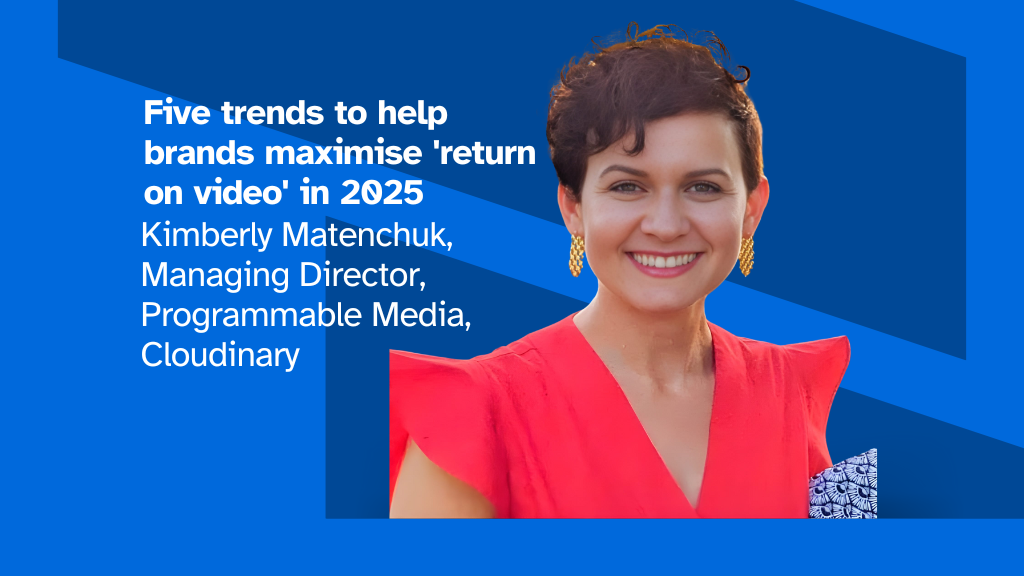by Kimberly Matenchuk, Managing Director, Programmable Media, Cloudinary
Video has exploded in recent years, now accounting for the majority of all global Internet traffic. Much of video’s IP traffic comes from the big streaming companies – Netflix, Apple+ and the like. However video is also on the rise in the corporate world.
Earlier this year my company commissioned its first Global Video Survey across 15 countries. It found that brands are increasingly relying on video to build trust (78%), increase market awareness (65%) and drive purchases (54%). The fact that a whopping 81% anticipated they are “very likely” (35%) or “somewhat likely” (46%) to increase video use over online channels, growth seems sure to continue into 2025.
Through our work with brand leaders of all sizes, and managing video assets on an epic scale, we have gained detailed insights into some of the drivers for video’s expected growth. From infrastructure to legal, technology and creative, capitalizing on the five trends that follow will help brands maximise their return on video.
Trend #1: martech consolidation
Against a backdrop of marginal economic growth, inflation that’s cooling more slowly than expected, and low levels of consumption and investment, companies are naturally looking for efficiencies. We’re seeing many investigating or starting to consolidate and streamline their technology stacks and expect this work to gather pace in 2025.
Let’s look at the martech stack. It used to be a given that marketing teams completely owned their budgets and spend decisions. That meant they could buy the best-of-breed software from multiple vendors they favoured, without synching up with other departments. Recently we’ve seen greater marketing-led martech consolidation. This involves analyzing where requirements, capabilities and budgets overlap and rationalising tech investment with teams like sales and customer service.
For video, this means no longer using different digital asset management (DAM) systems for different content and departments. More companies are consolidating into using single, modern DAMs that can manage not only images, audio and documents, but also video assets – throughout their lifecycles.
A single source of truth also helps solve a low-profile but costly problem for global companies with distributed teams: the loss of video assets. From planning to shooting to post-production, the cost of creating video can easily run into the millions. Without a single source of truth DAM with granular permissions and controls, it’s all too easy to lose these valuable assets. People delete files by accident; hard drives fail; mobiles and laptops get lost or stolen; employees and contractors leave without documenting the location or status of key media assets.
Trend #2: Accessibility
With the European Accessibility Act (EAA) coming into force in June 2025, all companies doing business in the EU will need to offer their goods and services in an accessible way. For websites and mobile applications, the EAA has the same accessibility requirements as the Web Accessibility Directive, based on the Web Content Accessibility Guidelines (WCAG) 2.0. Videos must be accessible to a wider range of people with disabilities.
For video content, as for any non-text content, companies should provide text alternatives that can be converted to other formats, such as large print, Braille, speech, symbols or simpler language. One solution is to offer transcripts (or subtitles) or captions, which have long been a common SEO best practice for many companies. Moreover, soundless videos are on the rise and are already popular with young people.
Companies doing business in the European Union must comply with the EAA by June, so expect to see demand grow for tools that help automate the creation of video captions and transcripts. The good news is that these will also ultimately help reduce post-production costs. For example, advanced AI tools can not only transcribe video content, but also translate it and add it as an overlay to the video for use in different geographies.
Trend #3: Snack-sized is the new black
Looking at video formats, it’s the 3-30 second “snack-sized” videos that seem to be gaining the most ground. Younger generations are driving this trend, choosing to view through platforms like TikTok, Instagram, SnapChat and YouTube. Like the little black dress, this format is engaging, convenient, attention grabbing. It also travels well across online and social channels. By making these soundless videos with subtitles, brands can easily meet those EAA regs mentioned above.
Since many eCommerce videos are shot in three to four minute increments – technically long form – the ability to summarise and trim videos will be in high demand in 2025. In the spirit of working smarter, not harder, brands are looking at ways to standardise their short-form videos. By defining a standard set of poses and movements, and using AI and automation, they are turning long form into streamlined short form video frames. This type of automation also helps to reduce post-production costs and make the entire post-production process as streamlined and frictionless as possible.
Trend #4: UGC control and moderation capabilities
User-generated content (UGC) is also set to grow, and that will bring new challenges. Most brands are already aware that younger generations rely heavily on UGC videos to assess a brand’s authenticity, trust and social proof.
Our video survey showed that 69% of companies allow users to share videos on their website/apps because they believe it engages their audience (79%), provides an authentic user experience (63%) and is good for SEO (44%). In addition, users can provide a fresh perspective. For those brands that don’t allow UGC videos, the top concerns are lack of brand alignment (56%), legal concerns (51%), and fear of inappropriate content (41%).
Fortunately, AI-based capabilities make it possible to create and automate workflows for moderating and controlling UGC videos. For example, logo detection in video frames or sound detection to ensure that competitors aren’t mentioned or that the content isn’t profane or inappropriate. With these features in place, by 2025 we will see brands that have been reluctant in the past, now embrace UGC videos.
Trend #5: GenAI video questions and concerns
Despite all the public debate about GenAI, it still has lower adoption for brand videos. GenAI for video is even more complex than GenAI for images, and brands have many of the same concerns as they do with UGC videos. Crucially, how to ensure that AI-generated videos adhere to brand guidelines, look authentic and don’t cause harm.These are just some of the issues to solve before GenAI videos really take off.
Solving the big issues requires transparency. How and what data are models trained on? Are data sets ethically correct and not reproducing any biases? Can people give feedback on the model and ensure it’s actually learning? These are just a few of the questions and concerns that need further attention.
An interesting, perhaps counter-intuitive concern is the fear that GenAI video will look better than the actual product. When this happens, there is a high risk that disappointed customers will return goods and leave bad reviews. Getting the balance right is something brands will have to learn if they want to score with GenAI videos in 2025.
Without question, video offers so many advantages when it comes to communicating, inspiring, entertaining and doing commerce online. It also brings new challenges and requires people to develop a new set of skills and knowledge. Integrating these five trends into their strategies will help brands to minimise the risk factors, offer wider accessibility, and gain the highest ‘return on video’ in 2025.









